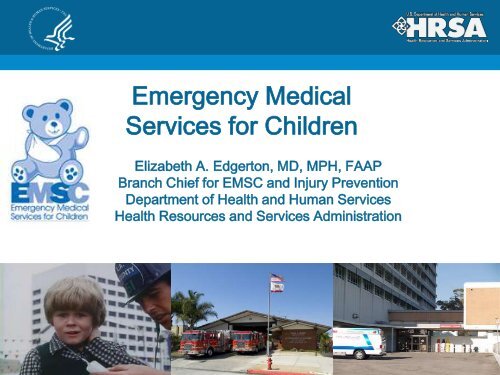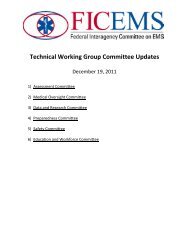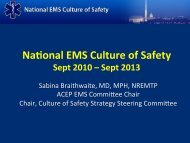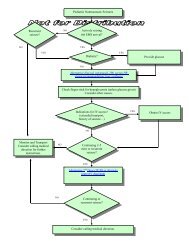Emergency Medical Services for Children - NHTSA EMS
Emergency Medical Services for Children - NHTSA EMS
Emergency Medical Services for Children - NHTSA EMS
You also want an ePaper? Increase the reach of your titles
YUMPU automatically turns print PDFs into web optimized ePapers that Google loves.
<strong>Emergency</strong> <strong>Medical</strong><strong>Services</strong> <strong>for</strong> <strong>Children</strong>Elizabeth A. Edgerton, MD, MPH, FAAPBranch Chief <strong>for</strong> <strong>EMS</strong>C and Injury PreventionDepartment of Health and Human <strong>Services</strong>Health Resources and <strong>Services</strong> Administration
2006 Institute of Medicine<strong>Emergency</strong> Care For <strong>Children</strong>:Growing Pains“Un<strong>for</strong>tunately, although childrenmake up 27 percent of all visits tothe ED, many hospitals and <strong>EMS</strong>agencies are not well equipped tohandle these patients.”
Considerations• On average, 10% of <strong>EMS</strong> runs involve children andadolescents (rare event)• 90% of ED visits by children occur in hospitals notspecifically designed to treat children. (pediatrichospital recognition)• Last national assessment of EDs showed that only6 % of EDs in the United States have all therecommended equipment and medication neededto treat children (pediatric readiness)
The Origins of <strong>EMS</strong>CJune 15, 2011 CONGRESSIONAL RECORD—SENATEEMERGENCY MEDICAL SERVICES FOR CHILDREN PROGRAMMr. INOUYE. Mr. President, I rise today to speak about the importance of the<strong>Emergency</strong> <strong>Medical</strong> Service <strong>for</strong> <strong>Children</strong>, or <strong>EMS</strong>C, Program. Recently, wecelebrated National <strong>EMS</strong>C Day, an annual event raising awareness about theneed to improve and expand specialized care <strong>for</strong> children in the prehospitaland acute care settings. The <strong>EMS</strong>C Program holds great personal importanceto me. More than 30 years ago, Senator HATCH and I, on a bipartisan basis, tooknote of the systematic problems and deficiencies surrounding emergency care <strong>for</strong>children. With these deficiencies in mind, we authoredlegislation to address the gaps in emergency care <strong>for</strong> children.Through the support of the American Academy of Pediatrics and theSurgeon General the bill became law in 1984 authorizing Federal funding <strong>for</strong><strong>EMS</strong>C.
Patient Protection andAf<strong>for</strong>dable Care Act of 2010The <strong>Emergency</strong> <strong>Medical</strong> <strong>Services</strong> <strong>for</strong> <strong>Children</strong>(<strong>EMS</strong>C) Program is authorized under section 1910 ofthe Public Health Service Act (42 U.S.C. 300w–9).It is the only Federal program that focuses specificallyon improving the pediatric components of emergencymedical care.
Mission of <strong>EMS</strong>CThe <strong>EMS</strong>C Program addresses the entirecontinuum of pediatric emergency services,from injury prevention and <strong>EMS</strong> accessthrough out-of-hospital and emergencydepartment care, intensive care,rehabilitation and reintegration into thecommunitySenator Inouye 6-14-11
<strong>EMS</strong>C PortfolioGrants14.4 Million ( 73%)Support <strong>Services</strong>4.3 Million (22%)IAA0.675 Million (3%)• PECARN (6)• Targeted Issue (9)• State Partnership (59)• Regionalization of Care (4)• Data Coordinating Center(DCC)• National Resource Center(NRC)• DOT/NHSTA -Office of<strong>EMS</strong>• Indian Health Service• Agency <strong>for</strong> Health CareResearch AHRQ
FY2012<strong>NHTSA</strong>IHSAdmin2%1%8%PECARNNRC7%18%DCC13%TargetedIssues13%SPROC4%StatePartnerhsip34%
<strong>EMS</strong>C StatePartnership ProgramProvides funding to 49 states, DC, and 5territories to improve pediatric care throughper<strong>for</strong>mance measures:• <strong>Medical</strong> direction• Pediatric equipment• Facility recognition• Inter-facility transfer• Institutionalization of <strong>EMS</strong>C in the Statesystem
Collecting the Data<strong>EMS</strong>C Program
<strong>EMS</strong>C Per<strong>for</strong>mance MeasureData Collection• Data collected from <strong>EMS</strong> agencies• Over 6,300 agencies surveyed• Overall survey response rate was 82%• Data collected from hospitals• 2,644 hospitals surveyed• Overall survey response rate was 79%• More in<strong>for</strong>mation available at www.nedarc.org
From <strong>EMS</strong> Preparedness….….to ED Preparedness
The National Pediatric ReadinessAssessment• Based on 2009 NationalGuidelines.• Developed by ReadinessWorking group• Web based survey• Nurse Leader to completethe survey• Released in Cali<strong>for</strong>niaJanuary 2012• National roll out-2013
NationalPediatricReadinessSurvey
National Pediatric ReadinessAssessment
Improving Knowledge aboutPediatric <strong>Emergency</strong> CareTargeted Issue Grants• Issues of national significance with potential toimprove practice in the field.• Many focus on the pre-hospital environment.Pediatric <strong>Emergency</strong> Care AppliedResearch Network (PECARN)• Creating an infrastructure to conduct rigorousstudies in pediatric emergency care.• Use of medications in the pre-hospital setting.
PECARN StructureDataCoordinatingCenter (DCC)PI: Mike DeanProtocol Reviewand DevelopmentPECARNSteering CommitteeQuality Assurance,Safety andRegulatoryFeasibilityand BudgetPECARN SubcommitteesGrantWriting andPublicationHRSA/MCHB/<strong>EMS</strong>CFederal Project Officer:Tasmeen WeikPediatric <strong>Emergency</strong>Medicine Northeast,West and SouthPEM-NEWSPI: Peter DayanGreat Lakes<strong>Emergency</strong> <strong>Medical</strong><strong>Services</strong> <strong>for</strong> <strong>Children</strong>Research NetworkGL<strong>EMS</strong>CRNPI: Rachel StanleyWashington, Boston,Chicago AppliedResearch NodeWBCARNPI: Jim ChamberlainHospitals of theMidwest <strong>Emergency</strong>Research NodeHOMERUNPI: Rich RuddyPittsburgh, RhodeIsland, DelawareNetworkPRIDENETPI: Bob HickeyPediatric Research inInjuries and <strong>Medical</strong>EmergenciesPRIMEPI: Nate Kuppermann
Publications• PECARN has published 33 papers and 68 abstracts.• Recent publications include:• Identifying children at very low risk of clinically-important traumatic braininjuries after blunt head trauma. Lancet 2009;374:1160-1170• Factors associated with cervical spine injury in children following blunttrauma. Ann Emerg Med 2010• A new diagnosis grouping system <strong>for</strong> child emergency departmentvisits. Acad Emerg Med 2010;17:204-210• Multicenter cohort study of out-of-hospital pediatric cardiac arrest. CritCare Med 2010• The effect of observation on head computed tomography (CT) utilization<strong>for</strong> children after blunt head trauma. Pediatrics 2011
Background: Targeted Issues Grants• Typically, the projects result in a new product or resource ordemonstrate the effectiveness of a model system component orservice of value.• Objectives must meet a demonstrable need. Methodologies andstrategies <strong>for</strong> achieving the objectives must be realistic, appropriate,and scientifically sound. Each project must contain an evaluationplan that contains measurable outcomes and clearly defined timeframes <strong>for</strong> conducting the evaluation.• Awards range up to $300,000 per year <strong>for</strong> up to three years.• In FY 2010, the <strong>EMS</strong>C Program awarded nine new TI grants, eachreceiving up to $300,000 a year <strong>for</strong> up to three years. Anticipate anew competitive competition in FY2013.
Current TI GrantsGrants focusing on Disasters and Preparedness• Connecticut: (Year 2) “Small Victims, Big Challenges: Refining Pediatric DisasterTriage Algorithms and Education in the Prehospital Setting.”• Massachusetts: (Continuation) “REUNITE: A Novel Imaging System <strong>for</strong> <strong>Children</strong>Separated During Disaster.”Grants focusing on Regionalization and <strong>EMS</strong> Systems• Illinois: (Year 2) “Pediatric Facility Recognition/Categorization: Models of BestPractice, Implementation and Evaluation.”• North Carolina: (Year 2) “<strong>EMS</strong> and Pediatric Trauma: A North Carolina PopulationBased Per<strong>for</strong>mance Improvement Intervention and Evaluation Using Multiple LinkedHealthcare Databases.”• North Carolina: (Year 2) “Evaluation of a Pediatric <strong>Emergency</strong> Care RecognitionProgram on Care of Injured <strong>Children</strong>.”
Current GrantsGrants focusing on Clinical Efficacy and Patient Safety• Cali<strong>for</strong>nia: (Year 2) “Utility of Abdominal Ultrasound during <strong>Emergency</strong> Department Evaluation of<strong>Children</strong> with Blunt Trauma.”• Michigan: (Year 2) “Progesterone <strong>for</strong> Traumatic Brain Injury in <strong>Children</strong>: Planning a Safety andEfficacy Trial.”• Michigan: (Continuation) “Michigan Pediatric Errors and Excellence Discovery with Simulation.”• Texas: (Year 2) “Integrating Evidence-Based Pediatric Prehospital Protocols into Practice.”• Washington, DC: (Year 2) “Reducing Errors in Pediatric Trauma Resuscitation Using aChecklist.”• Washington, DC: (Continuation) “Family Presence During Pediatric Trauma Team Activation:Measuring the Effects of a Multidisciplinary Approach to Patient-Family-Centered Care.”Grants focusing on Injury and Illness Prevention• Connecticut: (Continuation) “Efficacy of Driving Simulator Training <strong>for</strong> Novice Teen Drivers.”• Massachusetts: (Year 2) “ExSTRA: Evidence-Based Screening <strong>for</strong> Siblings and Contacts ofAbused <strong>Children</strong>.”
<strong>EMS</strong>C NRC
Dissemination & KnowledgeTransfer• Engage diverse stakeholder groups (acrossdisciplines and systems of care)• Support <strong>for</strong>ums <strong>for</strong> strategic partnership• Adoption of policy, guidelines, or evidence• Disseminate current best practices toappropriate audiences (grantees, providers,public, decision makers)• Support initiatives to institutionalize <strong>EMS</strong>Cwithin other systems of care
<strong>EMS</strong>C Initiatives• Knowledge translation of PECARNfindings• Clinical decision making <strong>for</strong> mild TBI• Pediatric Readiness Initiative• 22 stakeholder groups• Evidence Based Guideline (EBG) protocoldevelopment• Impacts practice in <strong>EMS</strong> field• Regionalization of care
State Partnership Regionalization ofCare (SPROC) Program• Program intends to develop Models of Inclusive Care that can bereplicated in other regions were access to specialized pediatricmedical treatment is limited due to geographical distances orjurisdictional borders• Focus is to develop regionalized systems that encompass thesharing of resources and improved access to pediatric healthcareservices <strong>for</strong> children and families in tribal, territorial, insular and ruralareas• In June 2012, HRSA awarded $1.2 million over the next four yearsto six awardees: Alaska, Arizona, Cali<strong>for</strong>nia, Montana, New Mexico,Pennsylvania
Training• The <strong>EMS</strong>C National ResourceCenter has free resourcesaccessible by public.• Online trainings• Searchable resources• Disaster Preparedness• Fact sheets• Educational curricula on pediatrics• Podcasts on patient safety• Print ready materials <strong>for</strong> grantees<strong>for</strong> <strong>EMS</strong>C related events
Research - Publications• QuickNews is aweekly listservmessage that isdisseminated to over700 subscribers.Academic articles thatmay be of interest tothe pre-hospital andhospital communityare also featured.
Initiatives At <strong>EMS</strong>C<strong>NHTSA</strong> -Federal <strong>EMS</strong>C Program• Support of <strong>EMS</strong> Leadership• FIC<strong>EMS</strong>• N<strong>EMS</strong>AC• NAS<strong>EMS</strong>O• Preshospital Education-National Standards• Evidence-Based Guidelines Framework• <strong>EMS</strong> pediatric protocols• Helicopter transport protocols• Culture of Safety
Initiatives At <strong>EMS</strong>CIndian Health Service-Federal <strong>EMS</strong>C Program• Ensure the presences of <strong>EMS</strong>C in the delivery of care• Supporting pediatric specific training in prehospitaland hospital setting• Supporting regionalization of care with StatePartnership Grants• Integrating Pediatric Readiness into IHS Quality ofCare Initiative• Integrating activities of the AAP Committee on NativeAmerican Child Health
What is <strong>EMS</strong>C doingQuality Improvement• State Partnership Grants• State Partnership-Regionalization of CareKnowledge Generation• Targeted Issues Grants• Pediatric <strong>Emergency</strong> Care Applied ResearchNetwork-PECARNSupport & Dissemination<strong>EMS</strong>C National Resource Center<strong>EMS</strong>C Data Coordinating Center
Contact In<strong>for</strong>mationElizabeth Edgerton, MD, MPH, FAAPBranch Chief <strong>EMS</strong>C and Injury PreventionMCHB/HRSAeedgerton@hrsa.gov









